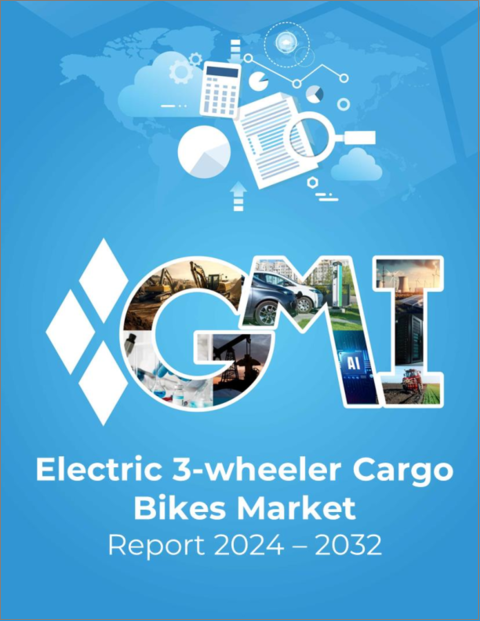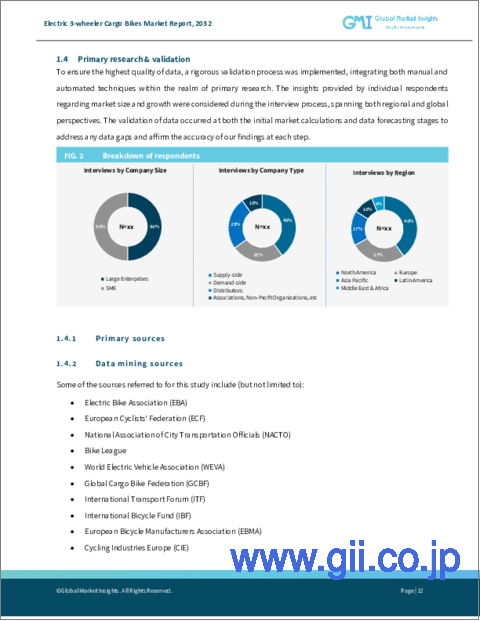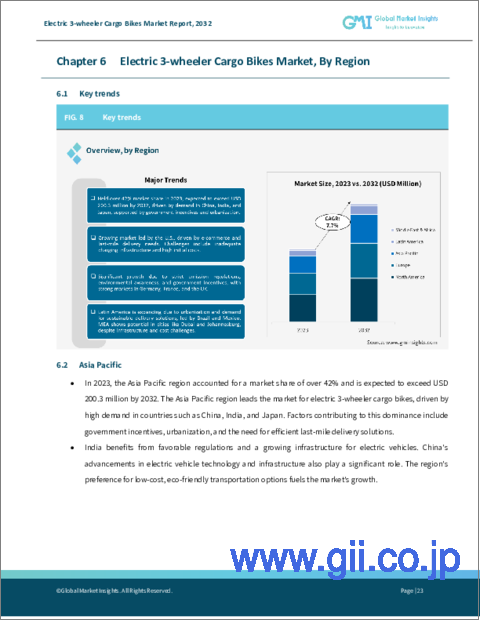|
|
市場調査レポート
商品コード
1570923
電動3輪カーゴバイク市場、市場機会、成長促進要因、産業動向分析と予測、2024年~2032年Electric 3-wheeler Cargo Bikes Market, Opportunity, Growth Drivers, Industry Trend Analysis and Forecast, 2024-2032 |
||||||
カスタマイズ可能
|
|||||||
| 電動3輪カーゴバイク市場、市場機会、成長促進要因、産業動向分析と予測、2024年~2032年 |
|
出版日: 2024年08月08日
発行: Global Market Insights Inc.
ページ情報: 英文 252 Pages
納期: 2~3営業日
|
全表示
- 概要
- 目次
電動3輪カーゴバイクの世界市場は、2023年には2億3,160万米ドルとなり、2023年から2032年までのCAGRは7.7%以上と予測されます。
都市化とeコマースの拡大がこの動向の大きな原動力となっています。都市人口の増加に伴い、都市では交通渋滞や公害が増加し、持続可能な輸送ソリューションへのシフトが促されています。電動3輪カーゴバイクは環境に優しい代替手段を提供し、配送効率を向上させる。eコマースの台頭により、迅速なラスト・マイル・デリバリー・サービスへの需要が高まっており、これらのバイクは混雑した道路を移動するのに適しているため、消費者の玄関先への直接配達を確実に行うことができます。運用コストの削減と環境フットプリントの低減は、持続可能なロジスティクス・オプションを求める企業にとって魅力的です。さらに、電気自動車導入のための補助金、税制優遇措置、助成金などのインセンティブが、これらのバイクをさらに経済的に魅力的なものにしています。
市場は最終用途別に物流・配送、小売・卸売、建設、農業、その他に区分されます。2023年には、物流・配送分野が45%以上の市場シェアを占め、2032年には2億1,200万米ドルを超えると予測されています。eコマースやオンデマンド・デリバリー・サービスの台頭により、効率的なラストマイル配送ソリューションへの需要が高まっています。電動3輪車は、都市部の商品輸送に費用対効果が高く、環境に優しい代替手段を提供します。低運用コストとゼロエミッションは、二酸化炭素排出量の削減を目指す企業にとって魅力的です。電気自動車に対する政府の優遇措置や補助金が、このセグメントの優位性をさらに支えています。
市場は電池をリチウムイオン、ニッケル水素、鉛蓄電池に分ける。2023年の市場シェアは、リチウムイオン電池が約63%を占めています。リチウムイオン電池はエネルギー密度が高く、航続距離が長く、効率が高いです。軽量化により、車両性能と積載量が向上します。リチウムイオンバッテリーは充電時間が短く、ダウンタイムと運用コストを削減できます。これらの利点により、商業用途に適しています。リチウムイオン技術のコストが低下しているため、初期コストは高いもの、リチウムイオン電池の採用が進んでいます。
2023年、アジア太平洋地域の市場シェアは42%を超え、2032年には2億30万米ドルを超えると予想されています。中国、インド、日本における需要の高さが、この優位性を後押ししています。その要因には、政府のインセンティブ、都市化、効率的なラストマイル配送ソリューションの必要性などがあります。インドは、有利な規制と電気自動車インフラの成長から利益を得ています。中国の電気自動車技術とインフラの進歩も重要な要因です。この地域では、手頃な価格で環境に優しい輸送ソリューションに対する需要が市場拡大の原動力となっています。
目次
第1章 調査手法と調査範囲
第2章 エグゼクティブサマリー
第3章 業界洞察
- エコシステム分析
- サプライヤーの状況
- 原材料サプライヤー
- 部品メーカー
- 自動車組立メーカー
- 流通ネットワーク
- アフターサービス・プロバイダー
- 利益率分析
- 技術革新の状況
- 特許分析
- 主要ニュースと取り組み
- 規制状況
- 影響要因
- 促進要因
- 都市化の進展とeコマースの成長
- 環境問題への懸念と排出規制
- 費用対効果と運用コストの低さ
- バッテリーと充電ソリューションの技術的進歩
- 業界の潜在的リスク&課題
- 航続距離とバッテリー寿命の制限
- 不十分な充電インフラ
- 促進要因
- 成長可能性分析
- ポーター分析
- PESTEL分析
第4章 競合情勢
- イントロダクション
- 企業シェア分析
- 競合のポジショニング・マトリックス
- 戦略展望マトリックス
第5章 市場推計・予測:積載容量別、2021年~2032年
- 主要動向
- 軽
- 中型
- 重量
第6章 市場推計・予測:バッテリー別、2021年~2032年
- 主要動向
- リチウムイオン
- 鉛蓄電池
- ニッケル水素
第7章 市場推計・予測:出力別、2021年~2032年
- 主要動向
- 1000W以下
- 1000W以上3000W未満
- 3000W以上
第8章 市場推計・予測:用途別、2021年~2032年
- 主要動向
- 物流・配送
- 小売・卸売
- 建設・農業
- その他
第9章 市場推計・予測:地域別、2021年~2032年
- 主要動向
- 北米
- 米国
- カナダ
- 欧州
- 英国
- ドイツ
- フランス
- スペイン
- イタリア
- ロシア
- 北欧
- その他欧州
- アジア太平洋
- 中国
- インド
- 日本
- 韓国
- ニュージーランド
- 東南アジア
- その他アジア太平洋
- ラテンアメリカ
- ブラジル
- メキシコ
- アルゼンチン
- その他ラテンアメリカ
- 中東・アフリカ
- UAE
- 南アフリカ
- サウジアラビア
- その他の中東・アフリカ
第10章 企業プロファイル
- Amsterdam Bicycle Company
- Babboe
- Black Iron Horse
- Bunch Bikes
- Butchers and Bicycles
- Clamberbikes
- Cube 50
- Electric Bike Technology, Inc.
- Hagen
- Kuake Bicycle
- Laplandar
- NIHOLA
- Nijland Cycling
- Raleigh UK Ltd.
- Triobike
- Urban Arrow
- Winora Group
- Worksman Cycles
- Xuzhou Beiji Vehicle Co., Ltd.
- XYZ CARGO
The Global Electric 3-Wheeler Cargo Bikes Market was valued at USD 231.6 million in 2023, with a projected CAGR of over 7.7% from 2023 to 2032. Urbanization and the expansion of e-commerce are major driving forces behind this trend. As urban populations grow, cities experience increased traffic congestion and pollution, prompting a shift towards sustainable transportation solutions. Electric 3-wheeler cargo bikes provide an eco-friendly alternative, improving delivery efficiency. The rise of e-commerce has heightened the demand for fast last-mile delivery services, and these bikes are well-suited to navigate congested streets, ensuring direct deliveries to consumers' doorsteps. Their lower operational costs and reduced environmental footprint appeal to businesses looking for sustainable logistics options. Additionally, incentives such as subsidies, tax breaks, and grants for electric vehicle adoption make these bikes even more financially attractive.
The overall electric 3-wheeler cargo bikes industry is classified based on the payload capacity, battery, power output, end-user, and region.
The market segments by end-use into logistics and delivery, retail and wholesale, construction, agriculture, and others. In 2023, the logistics and delivery segment held over 45% market share and is expected to exceed USD 212.0 million by 2032. The rise of e-commerce and on-demand delivery services increases demand for efficient last-mile delivery solutions. Electric 3-wheelers offer a cost-effective and eco-friendly alternative for urban goods transportation. Their lower operating costs and zero emissions appeal to businesses aiming to reduce their carbon footprint. Government incentives and subsidies for electric vehicles further support this segment's dominance.
The market divides batteries into lithium-ion, nickel-metal hydride and lead-acid. The lithium-ion segment held around 63% market share in 2023. These batteries dominate due to their superior energy density, enabling longer driving ranges and higher efficiency. Their lighter weight enhances vehicle performance and cargo capacity. Lithium-ion batteries offer faster charging times and reduced downtime and operational costs. These advantages make them suitable for commercial applications. The declining cost of lithium-ion technology boosts their adoption, making them the preferred choice despite higher initial costs.
In 2023, the Asia Pacific region accounted for over 42% market share and is expected to exceed USD 200.3 million by 2032. High demand in China, India, and Japan drives this dominance. Factors include government incentives, urbanization, and the need for efficient last-mile delivery solutions. India benefits from favorable regulations and growing electric vehicle infrastructure. China's progress in electric vehicle technology and infrastructure is also a key factor. The region's demand for affordable, environmentally friendly transportation solutions drives market expansion.
Table of Contents
Chapter 1 Methodology and Scope
- 1.1 Research design
- 1.1.1 Research approach
- 1.1.2 Data collection methods
- 1.2 Base estimates and calculations
- 1.2.1 Base year calculation
- 1.2.2 Key trends for market estimates
- 1.3 Forecast model
- 1.4 Primary research and validation
- 1.4.1 Primary sources
- 1.4.2 Data mining sources
- 1.5 Market definitions
Chapter 2 Executive Summary
- 2.1 Industry 360° synopsis, 2021 - 2032
Chapter 3 Industry Insights
- 3.1 Industry ecosystem analysis
- 3.2 Supplier landscape
- 3.2.1 Raw material suppliers
- 3.2.2 Component manufacturers
- 3.2.3 Vehicle assemblers
- 3.2.4 Distribution network
- 3.2.5 After-sales service providers
- 3.3 Profit margin analysis
- 3.4 Technology and innovation landscape
- 3.5 Patent analysis
- 3.6 Key news and initiatives
- 3.7 Regulatory landscape
- 3.8 Impact forces
- 3.8.1 Growth drivers
- 3.8.1.1 Rising urbanization and e-commerce growth
- 3.8.1.2 Environmental concerns and emission regulations
- 3.8.1.3 Cost-effectiveness and low operational costs
- 3.8.1.4 Technological advancements in battery and charging solutions
- 3.8.2 Industry pitfalls and challenges
- 3.8.2.1 Limited range and battery life
- 3.8.2.2 Inadequate charging infrastructure
- 3.8.1 Growth drivers
- 3.9 Growth potential analysis
- 3.10 Porter's analysis
- 3.11 PESTEL analysis
Chapter 4 Competitive Landscape, 2023
- 4.1 Introduction
- 4.2 Company market share analysis
- 4.3 Competitive positioning matrix
- 4.4 Strategic outlook matrix
Chapter 5 Market Estimates and Forecast, By Payload Capacity, 2021 - 2032 ($Mn, Units)
- 5.1 Key trends
- 5.2 Light
- 5.3 Medium
- 5.4 Heavy-duty
Chapter 6 Market Estimates and Forecast, By Battery, 2021 - 2032 ($Mn, Units)
- 6.1 Key trends
- 6.2 Lithium-ion
- 6.3 Lead-acid
- 6.4 Nickel-metal hydride
Chapter 7 Market Estimates and Forecast, By Power Output, 2021 - 2032 ($Mn, Units)
- 7.1 Key trends
- 7.2 Up to 1000W
- 7.3 1000W to 3000W
- 7.4 Above 3000W
Chapter 8 Market Estimates and Forecast, By End-Use, 2021 - 2032 ($Mn, Units)
- 8.1 Key trends
- 8.2 Logistics and delivery
- 8.3 Retail and wholesale
- 8.4 Construction and agriculture
- 8.5 Others
Chapter 9 Market Estimates and Forecast, By Region, 2021 - 2032 ($Mn, Units)
- 9.1 Key trends
- 9.2 North America
- 9.2.1 U.S.
- 9.2.2 Canada
- 9.3 Europe
- 9.3.1 UK
- 9.3.2 Germany
- 9.3.3 France
- 9.3.4 Spain
- 9.3.5 Italy
- 9.3.6 Russia
- 9.3.7 Nordics
- 9.3.8 Rest of Europe
- 9.4 Asia Pacific
- 9.4.1 China
- 9.4.2 India
- 9.4.3 Japan
- 9.4.4 South Korea
- 9.4.5 ANZ
- 9.4.6 Southeast Asia
- 9.4.7 Rest of Asia Pacific
- 9.5 Latin America
- 9.5.1 Brazil
- 9.5.2 Mexico
- 9.5.3 Argentina
- 9.5.4 Rest of Latin America
- 9.6 MEA
- 9.6.1 UAE
- 9.6.2 South Africa
- 9.6.3 Saudi Arabia
- 9.6.4 Rest of MEA
Chapter 10 Company Profiles
- 10.1 Amsterdam Bicycle Company
- 10.2 Babboe
- 10.3 Black Iron Horse
- 10.4 Bunch Bikes
- 10.5 Butchers and Bicycles
- 10.6 Clamberbikes
- 10.7 Cube 50
- 10.8 Electric Bike Technology, Inc.
- 10.9 Hagen
- 10.10 Kuake Bicycle
- 10.11 Laplandar
- 10.12 NIHOLA
- 10.13 Nijland Cycling
- 10.14 Raleigh UK Ltd.
- 10.15 Triobike
- 10.16 Urban Arrow
- 10.17 Winora Group
- 10.18 Worksman Cycles
- 10.19 Xuzhou Beiji Vehicle Co., Ltd.
- 10.20 XYZ CARGO





